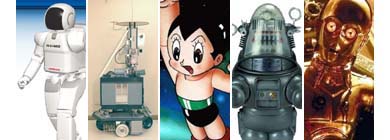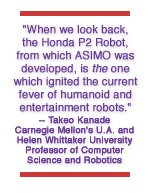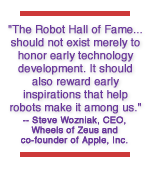|
|
||||
|
|
Carnegie Mellon Announces New Inductees into "Robot Hall of Fame™"
Five robots will comprise the second class of inductees into Carnegie Mellon University's "Robot Hall of Fame™," established last year to honor both real and fictional robots and their creators in recognition of the increasing benefits robots are bringing to society. The 2004 class, which will be inducted on October 11, 2004, was announced June 17 at the Carnegie Science Center as part of the international press launch of 20th Century FOX's feature film "I, ROBOT", based on the novel by Isaac Asimov. FOX chose Pittsburgh as a launch-site for the film because of The Robot Hall of Fame and the significant research and development at the university's Robotics Institute. The film is scheduled for release in July.
ASIMO, a humanoid robot developed by Honda Motor Co., Ltd., and Shakey the Robot, the first mobile robot to reason about its actions, will be honored for their scientific achievements. Astroboy, C3PO, and Robby the Robot will be honored for their fictional characters and their real inspiration. The five robots were selected by a jury of leaders in technology-related fields.
"The jury discussed this year's candidates at length and has made some excellent choices," said Computer Science Professor James H. Morris, former dean of Carnegie Mellon's School of Computer Science and founder of the Robot Hall of Fame. "I'm happy to see some older, historically important robots like Shakey and Robby joining the newer ones like ASIMO and C3PO."
ASIMO drew juror support as one of the most successful humanoid robots ever created.
"When we look back, the Honda P2 Robot, from which ASIMO was developed, is the one which ignited the current fever of humanoid and entertainment robots," said juror Takeo Kanade, the U.A. and Helen Whitaker University Professor of Computer Science and Robotics at Carnegie Mellon.
A key purpose of the Robot Hall of Fame is to acknowledge the work of the early pioneers in robotics so that it will not be forgotten.
"I feel that the Robot Hall of Fame should give credit to the early scientific and engineering accomplishments which set foundations for further work in the robotic field," said juror Ruzena Bacjsy, director, CITRIS, University of California, Berkeley.
Shakey the Robot was created in 1969 at the Stanford Research Institute's Artificial Intelligence Center. Juror Illah Nourbakhsh, robotics group lead at NASA/Ames Research Center and associate professor of robotics at Carnegie Mellon's Robotics Institute, called it "an earth-shaking early robot."
"Shakey already sported a full planning system, a wireless video system and visual interpretation of its scene, visual obstacle avoidance, and the ability to manipulate the world via pushing. It even had a multi-level, tiered control architecture very similar to what many have settled upon today. In other words, it was way ahead of its time, and set a standard for a great many years," Nourbakhsh explained.
Juror Steve Wozniak, CEO, Wheels of Zeus and co-founder of Apple, Inc., supported the selection of Astroboy, C3PO and Robby the Robot.
"The Robot Hall of Fame honors robots from science fiction as well as science, and should not exist merely to honor early technology development," Wozniak said. "It should also reward early inspirations that help robots make it among us."
"Astroboy should be inducted because of its extraordinary impact on Japanese culture, including its impact on the socialization of generations to a future in which robotics are a part of every day life," said juror Sherry Turkle, director of Massachusetts Institute of Technology's Initiative on Technology and Self. "Through the filter of both Japanese culture and industrial production, Astroboy has come to have a global reach."
C3PO will join his beloved colleague R2-D2, a member of the Robot Hall of Fame's charter class. The cheerful and well-intentioned robot is primarily known for his innocent bumbling and his incessant chatter in the Star Wars series.
"Along with R2-D2, C3PO is one of the most memorable characters from the Star Wars series," Morris said. "He demonstrates many appealing human traits. And, he received the most nominations from the public on the Robot Hall of Fame Web site. As jurors, we felt we needed to acknowledge that popular support."
Robby the Robot also received significant support online.
Joanna Haas, director of the Carnegie Science Center, which is home to the Robot Hall of Fame, explained that this robot, from MGM's 1956 science fiction epic "Forbidden Planet," became the iconic image of all science-fiction robots in the 1950s and beyond. "It was the first robot with a 'personality' conveyed through motion and timing," Haas said.
The Robot Hall of Fame's first class was inducted in November 2003. They were NASA's Mars Pathfinder Microrover Flight Experiment (MFEX), better known as "Sojourner"; Unimate, the first industrial robot; R2-D2, from the Star Wars trilogy; and the evil HAL-9000 computer, featured in the movie "2001: A Space Odyssey."
For more on the Robot Hall of Fame, visit www.robothalloffame.org.
Jenni Miller |
||
|
Carnegie Mellon Home |
||||

 Morris supported ASIMO because, "it was the first to demonstrate real human-like walking along with vision."
Morris supported ASIMO because, "it was the first to demonstrate real human-like walking along with vision."
 The Japanese Astroboy, known in its early years as Atom Boy, received well-deserved juror support. Astroboy, the animation of a robot with a soul, was created by Osamu Tezuka in 1951.
The Japanese Astroboy, known in its early years as Atom Boy, received well-deserved juror support. Astroboy, the animation of a robot with a soul, was created by Osamu Tezuka in 1951.